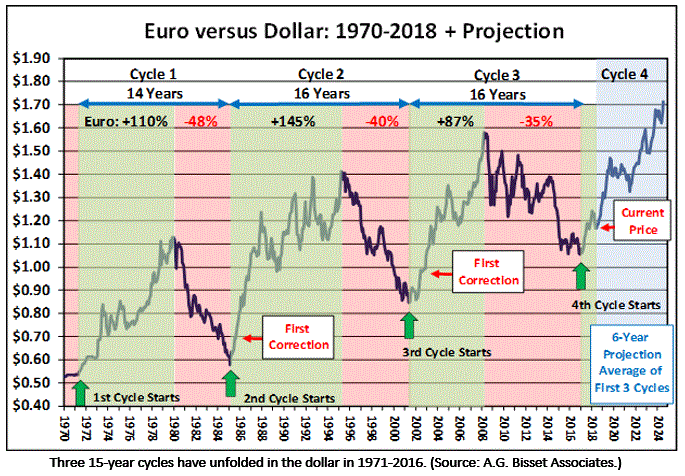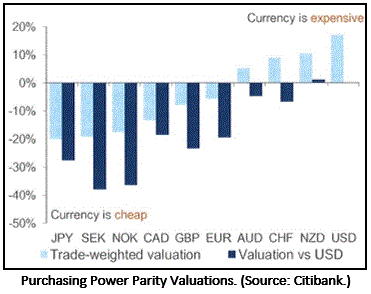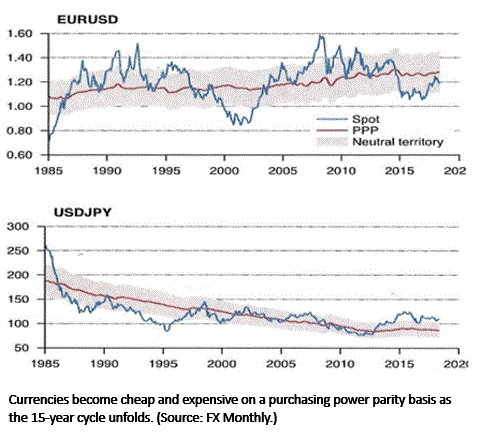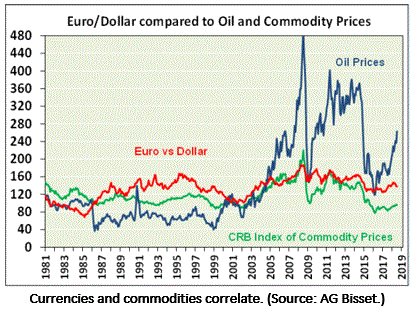How Will The Dollar’s 15-Year Cycle Impact Investors
Start of New 15-Year Dollar Cycle Points to 40% Dollar Decline
“We use the dollar as a lens to assess how trends will unfold in the dollar and other markets since the dollar is the most important price of all prices. Its cyclical long-term trends cause investors, consumers, governments and companies to change their investment and buying patterns as the dollar becomes expensive or cheap. The start of a new 15-year cycle in the dollar points to the dollar falling 40% against the euro and other currencies in the immediate years ahead. The global purchasing power of family offices and investors with large investments in dollar-denominated assets will see their global net worth plummet. Investors urgently need to address this risk and they need to implement a strategic long-term plan to avoid the large losses the dollar’s decline will cause as well as turn its decline into an opportunity to profit as currencies rise.”
Ulf J. Lindahl, CIO, A.G. Bisset Associates, LLC
>> Dollar’s 15-Year Cycle
A new 15-year cycle began in the dollar in January 2017. As the cycle unfolds into 2024, the dollar’s coming decline will have a massive impact on investors reducing their global net worth.
In the past three 15-year cycles, the dollar fell for an average of 8 years and its declines averaged 53% against the euro. That’s equal to the euro rising 114% against the dollar. The DM, which preceded the euro, rose 110% against the dollar in the first cycle; 145% in the second cycle, and the euro then rose 87% against the dollar in the third cycle. The cycle that started in 2017 can be projected to be as large as the prior three 15-year cycles.

>> Strategic Decisions by Investors Related to Dollar Exposure
Global investors have become excessively exposed to dollar-denominated assets. Allocations to U.S. assets have been driven higher by the superior performance of U.S. equities and bond yields that are higher than those in Europe and Asia.
As the 15-year cycle unfolds and the dollar falls, investors will begin to reduce allocations down to or below their benchmarks, and they will increase their hedging of the dollar. This will add downward pressure on the dollar and it will accelerate is decline.
>> Dollar’s Impact on Investors
The behavior of investors will be driven by the 15-year cycle as the dollar falls steeply. This behavior is not incorporated in economic forecasting models. As a result, currency forecasts banks and economists make are unreliable and too short-term in their horizons to assist investors who must make difficult but critically necessary strategic decisions to avoid losses and to profit from the falling dollar as the cycle unfolds.
-
Dollar-based family offices and investors have a currency risk that is hidden and needs to be mitigated.
Their allocations to foreign assets will be beneficial when currencies rise. However, the global purchasing power of their dollar-based assets will shrink as the dollar falls. Family offices will wish to counter this loss to maintain their global purchasing power by increasing the exposure to rising currencies.
-
Euro-based investors, and investors based in other currencies, will see currency losses accumulate rapidly as the 15-year cycle unfolds and the dollar drops.
In 2008 to 2016 the rising dollar boosted U.S. equity returns when measured in euro. That is no longer the case. The coming large drop in the dollar will reduce and even erase underlying equity returns in the years ahead.
Investors with dollar-denominated fixed income will see the value drop dramatically when the dollar falls measured in euro. Treasuries are no longer a safe investment but one that will cause portfolio losses.
-
Dollar and euro-based investors who wish to profit can harvest gains when currencies rise against the dollar.
Using currency forward contracts or futures, the return can be added on top of underlying portfolio returns to compensate for low returns associated with fixed income investments.
>> Dollar is Overvalued, Why?
Purchasing Power Parity Against the Dollar
Currencies repeatedly become over and undervalued when measured by their purchasing power parity. As they become cheap or expensive, investors, companies and governments change their behavior to profit from and to counter the effects of low and high valuations, just as they change how they behave as interest rates rise and fall cyclically. Purchasing power parity is like a P/E for equities. When it is high, it is time to sell. When it is low, it is time to buy.
The euro was cheap and undervalued against the dollar on a purchasing power parity basis when new 15-year cycles started in 1985, 2001 and 2017. The euro and other major currencies remain significantly undervalued and are poised to rise against the dollar.


The euro was overvalued when the cycles peaked in the 1990s and in 2008. It was the same for the yen and other currencies. A rising currency typically overshoots its fair value to a point that causes the cycle to peak. They will likely do so again.
Today’s undervaluation of the euro, sterling and the yen against the dollar indicates that the 15-year cycle that started in 2017 will continue to unfold. These currencies must now rise significantly to eliminate their large undervaluation and to become expensive and overvalued. It will take several years. The 15-year cycle that started in 2017 can therefore be projected to be similarly large as the prior three cycles in which the dollar fell an average of 53% against the euro over 8 years. Most of that decline occurred in the first three years of the cycle.
Mean Reversion is a Powerful Force
Mean reversion is a strong and persistent force in the financial markets that exists and persists because investors seek cheap assets to buy and expensive assets to sell. It is true for currencies as well.
When a currency becomes cheap or expensive, investors, consumers, companies and governments begin to change their behavior. Their actions eventually initiate a turn in the cycle and reversion toward the mean begins. Since purchasing power parity has stood the test of time and mean reversion is a recurring and powerful force, both will continue to drive the dollar’s 15-year cycle in the years ahead. Simply put, a cork pushed under water will rise to the surface and pop above it.
Short-Term Obscures Big Picture
The daily flow of economic statistics and politics impact currencies; they create trends that last a few days or several months and they can be large from time to time. However, these fluctuations have little influence on the multi-year mean reversion that is required to correct a currency’s over or undervaluation. Once a 15-year cycle has turned and a currency that is cheap has started to rise, its initial purchasing power valuation will determine the duration of its long-term cyclical trend.
Short-term trends are important for traders, but less so for investors. Investors need a strategic plan that will protect their investments and their global net worth against the dollar’s large decline, and that can help them profit from the seldom seen opportunity that the start of a new 15-year cycle represents. Too much focus on short-term currency trends distracts and causes investors to overlook the Big Picture and miss opportunities.
Currencies and Commodities
Trends in commodity and oil prices have correlated strongly with trends in the euro against the dollar in the past 45 years. The correlation was particularly strong in Cycle 3 (2001-2016) and has remained strong.
The correlation demonstrates that the currency cycle is driven by the global economy and global forces that a single government has limited powers to change. Billions of people around the world working to better their lives cause economic growth and an increasing demand for commodities and energy.
Relative export over import prices are measured through terms-of-trade. It links the dollar to trends in commodities since they are traded in dollars. As commodity prices rise, commodity exporting countries and sovereign wealth funds receive more dollars. They sell dollars to import goods from around the world while wealth funds diversify their investments. As commodity and oil prices rise, foreign currencies rise with them.

Commodity prices are also pushed up as the dollar falls to compensate for its weakness. It adds cyclical downward pressure on the dollar. As commodity and oil prices rise, producers invest in more production. It takes time to develop new sources but when they come on stream, supply is increased, prices stabilize and then begin to fall; the cycles peak and go into reverse.
The dollar’s close link to the commodity cycle is also evidenced by a high correlation between trends in the euro against the dollar and price trends in “commodity-driven” currencies like the Australian dollar and Canadian dollar.
>> Risky Investment Climate? A Historical Perspective
The dollar’s multi-year decline that began in 2017 has a long way to go. The investment climate has become even more risky since the dollar’s decline will have a larger impact on investment portfolios and the net worth of family offices in this 15-year cycle than in the prior three. The start of the new cycle, its long duration, and the coming acceleration of the downward trend in the dollar, coupled with the high level of investment assets diversified globally, have made the investment climate for the coming two to three years particularly risky.
When the first 15-year cycle started in the dollar in 1971, institutional investors had not diversified globally. Diversification began in the second dollar cycle (1985-2001) when U.S. pension funds achieved international asset allocations in excess of 10%. In the third cycle (2001-2016), investors worldwide diversified aggressively and now typically exceed 30%.
The euro rose rapidly in the first three years of each of the past 15-year cycles. When a new major trend begins, investors first see it as a correction, as they do today. However, as the new trend becomes recognized, more and more investors begin to adjust their behavior to avoid losses and to profit. Their actions accelerate the trend and prices begin to move rapidly. As investors know, equity prices move up fast when a new bull market starts. It’s the same for currencies.
In past cycles, when investors outside the U.S. had a lower exposure to the dollar, they could absorb large losses when it fell. That is no longer true. Institutions and most family offices now have investments outside their home currency that typically exceed one third of their assets. When the dollar falls an additional 40% in this cycle it will have a proportionally much larger impact on returns and the net worth of investors than in the past. Investors are not prepared for this.
The euro rose rapidly in the first three years of each of the past 15-year cycles. When a new major trend begins, investors first see it as a correction, as they do today. However, as the new trend becomes recognized, more and more investors begin to adjust their behavior to avoid losses and to profit. Their actions accelerate the trend and prices begin to move rapidly. As investors know, equity prices move up fast when a new bull market starts. It’s the same for currencies.
Euro, Sterling and Yen-Based Investors
Investors with large investments in dollar-denominated assets cannot afford to be idle when the dollar falls 40% to 50% over the next few years. They will begin to reduce allocations and increasingly hedge the dollar. It will add downward pressure on the dollar and it will accelerate its fall. Astute investors need to act ahead of the crowd to avoid large losses.
Dollar-Based Investors
Some dollar-based investors passively hedge their currency exposure. As currencies rise, these hedges will have losses that must be paid. As payments grow, these investors will begin to close their hedges to stem the outflow of cash. When allocations were small, passive hedging losses could be tolerated. Today, when allocations can exceed 30%, these terminations will add to the demand for currencies and accelerate the dollar’s fall. Astute investors need to protect their net worth as the dollar falls.
Special thanks to our contributor:

Ulf J. Lindahl
Chief Investment Officer
A.G. Bisset Associates, LLC
+1 (203) 866-3540
ulf@agbisset.com
www.agbisset.com
A.G. Bisset Associates is a currency specialist with over 35 years of experience in advising and managing currency programs for institutional investors in North America and Europe. The firm employs a systematic and disciplined investment strategy to implement its return seeking Cycle-Based Currency Program and its Currency Overlay Programs designed to reduce currency losses.
